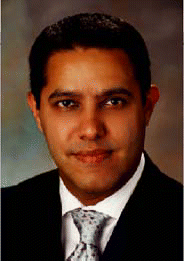TORONTO—Techniques in functional endoscopic sinus surgery (FESS) have come a long way since their inception, and there are new ways of working with patients. Experts discussed advances in FESS during a panel session at the annual AAO–HNS conference here.
Explore This Issue
December 2006In terms of technology, “the evolution of sinus imagery really has mirrored our sinus surgery evolution,” said Raj Sindwani, MD, session moderator and Assistant Professor at St. Louis University.
Today, “we have detailed registration processes, great reconstructions, and multimodel navigation capabilities. These are permitting us to really push the envelope as we chase disease processes into smaller recesses of the head,” he said.
For presurgical examinations, CT is the modality of choice. It shows great detail, especially of the bony ethmoid partitions, and simulates the endoscopic appearance of the sinus cavities. The advantages of multichannel CTs are speed, submillimeter scanning, and less exposure to radiation. “It’s quicker, and you get less motion artifact,” Dr. Sindwani said.
CT is used as a diagnostic tool, but is also valuable for preoperative planning. “Preoperative planning begins in the clinic when you’re looking at the CT for the first time,” he said. It should be followed up with operative planning on the computer workstation of the image guidance system in the OR, he said.
Generally, any systematic approach is useful with CT evaluation, he said. Dr. Sindwani starts with the coronals, looking anterior to posterior, then looks at the axial. With specific frontal sinus issues, he wants to see the sagittals.
There are several normal anatomic variants to watch for that may not need surgery. Among these are a middle turbinate that can be paraxodically bent, or is pneumatized (concha bullosa). There can be ethmoid variants, haller cells, and giant ethmoid bullae that can be confusing. The agger nasi cell can be one of the most difficult to conceptualize, yet is vital in frontal sinus surgery—it shows up best in a sagittal CT cut.
“If there’s any disease associated with them, we would address them at the time of surgery,” Dr. Sindwani said. If there is no associated disease (such as concha bullosa with a clear ipsilateral maxillary sinus and ethmoid cells), then the concha bullosa is considered an anatomic variant and is left alone.
MRI, which is underutilized by otolaryngologists, can be used in a complementary study. It can reveal key details of sinsonasal masses, including the nature of a mass, its boundaries, extension, and levels of invasion. It can also elucidate different types of inflammatory sinus disease.

Leave a Reply